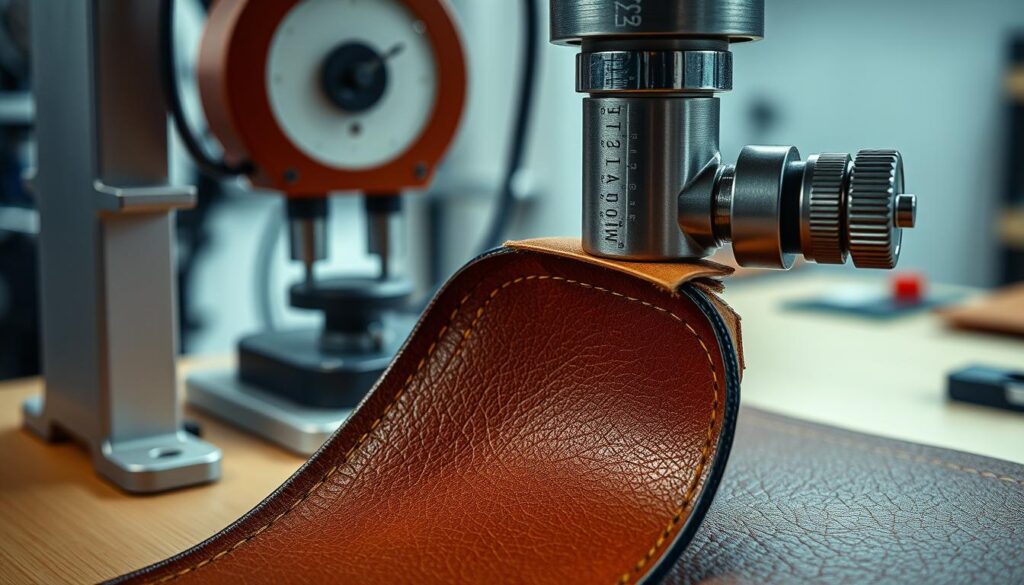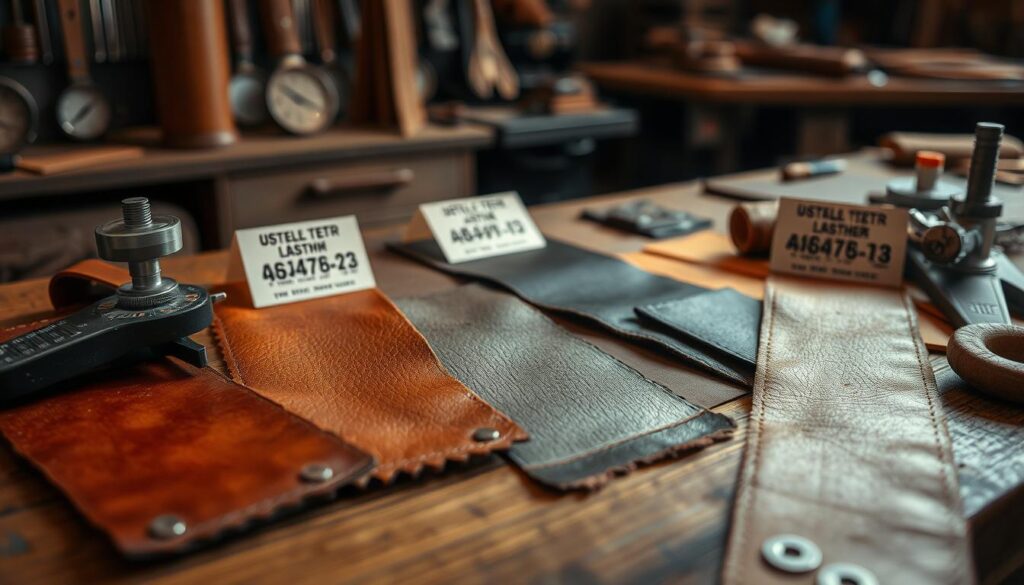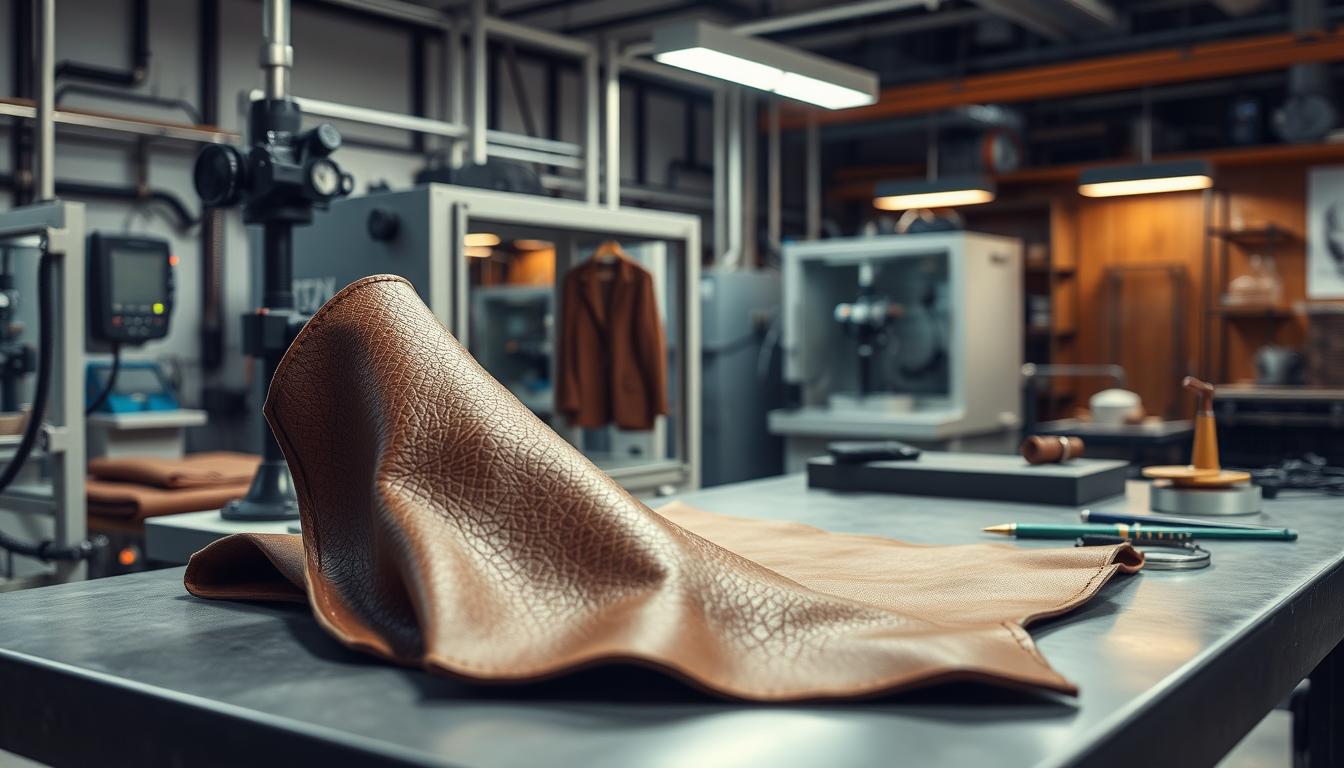I’ve seen many leather products fail because of bad quality control. It’s sad when a favorite jacket or bag breaks easily. That’s why testing leather’s strength is so important.
Without the right tests, makers might sell low-quality items. These items can upset customers and harm a company’s image. But, there’s a way to fix this. By doing tough tests on abrasion, tear, and tensile strength, companies can make sure their leather lasts long.
Key Takeaways
- Leather testing ensures product durability and quality
- Abrasion, tear, and tensile strength are crucial measures
- Testing follows international standards like ISO and ASTM
- Quality control is vital for various leather industries
- Specialized equipment is used for accurate strength testing
Introduction to Leather Performance Testing
Leather performance testing is key to ensuring top-quality leather. I’ve seen how these tests set industry standards. The Leather Performance Testing standard IS 5914 (1970) is a big deal. It covers many physical tests important for the trade.
Importance of Quality Control in Leather Production
Quality control in leather making is crucial. It’s not just about looks; it’s about lasting well and working right. The IS 5914 standard includes tests for thickness, area, density, and more. These tests help keep quality consistent and meet customer needs.
Overview of Key Strength Measures
Strength measures are the core of leather testing. Here’s a quick look at some key tests:
- Tensile strength
- Tear strength
- Water absorption
- Flexing endurance
- Resistance to compression
These tests, along with SATRA Testing Methods, check if leather can handle daily use. The standard matches international methods, making global trade in leather easier.
| Test Type | Purpose | Relevance |
|---|---|---|
| Tensile Strength | Measures maximum stress leather can withstand | Ensures durability |
| Water Absorption | Tests leather’s resistance to water | Indicates waterproofing quality |
| Flexing Endurance | Evaluates leather’s ability to bend repeatedly | Crucial for footwear and garments |
Knowing these strength measures is essential for making high-quality leather goods. These goods can last a long time.
Leather Performance Testing: Abrasion, Tear, and Tensile Strength
Testing leather is key to making sure products are good. The leather world uses different kinds, like cowhide and suede. These tests check how strong and durable leather is.
Abrasion Resistance Testing Methods
Abrasion tests show how leather holds up against wear. It rubs the leather with rough stuff to see how it does. This is important for things like shoes and couches.
Tear Strength Evaluation Techniques
Tear strength tests see how much force it takes to tear leather. The Baumann and stitch tear tests are common. They use machines that can apply up to 2000 N of force.

Tensile Strength Measurement Procedures
Tensile tests check how well leather can handle stretching. I cut leather into a special shape for this. Then, a machine stretches it until it breaks. This gives us important info for checking quality.
| Test Type | Standard | Equipment |
|---|---|---|
| Tear Strength | ISO 3377-2 | Tear Test Machine |
| Stitch Tear Resistance | ISO 23910 | MultiTest 2.5-i |
| Tensile Strength | ISO 3376 | MultiTest-i with pneumatic grips |
These tests help keep leather products high quality. They make sure they last long and work well.
SATRA Testing Methods for Leather
I’ve always been impressed by SATRA’s detailed approach to leather testing. They have 50 different methods. These cover everything from color fastness to water resistance. These tests are key for ensuring quality in the leather industry.
SATRA’s methods check many leather properties:
- Breaking strength and extension at break
- Tearing strength and needle penetration force
- Water absorption and shape retention
- Abrasion resistance and flexibility
- Moisture permeability and staining resistance
The SATRA TM17:1997 is a standout. It checks leather shrinkage temperature. This test is crucial for judging leather quality and durability.
For measuring thickness, SATRA uses the STM 483 gauge. This follows the TM1:2004 (2013) standard. Tear strength is tested with the ‘Baumann tear’ test (TM162:1992). Stretchability is checked with the ‘lastometer’ test (TM24:1992).
SATRA’s dedication to detailed leather testing helps manufacturers keep quality high. Their methods are a strong base for testing leather performance in different uses.
ASTM Standards in Leather Performance Testing
ASTM Standards are key in leather testing. They help keep quality high across the industry. Let’s look at some important ASTM tests for leather.
ASTM D7255: Abrasion Resistance of Leather
This test checks how leather holds up to wear and tear. It’s like the ASTM D4966-22 test for textiles. The leather is rubbed against an abrasive for many cycles. Then, how much weight is lost and how it looks are checked.
ASTM D2209: Tensile Strength of Leather
Tensile strength is about how much force leather can handle before breaking. In this test, leather is stretched until it tears. The highest force applied is recorded. For coated fabrics, 50 pounds per inch in both directions is the standard.

ASTM D4705: Stitch Tear Strength of Leather
This test sees how well leather resists tearing at seams. It’s important for items like shoes and bags. A machine pulls the leather apart at a seam. The force needed to tear it is measured. For coated fabrics, at least 15 pounds per inch is needed in both directions.
These ASTM Standards make sure leather products are up to par. They’re used by makers, sellers, and researchers to check leather’s durability and performance.
Assessing Leather Durability Through Performance Testing
Checking leather durability is key in the leather world. Performance tests are important for this. They check how leather holds up to different things.
When I test leather, I keep the environment the same. I use a temperature of 25±5°C and 50±10% humidity. This makes sure the tests are fair.
I use special tools for these tests. The SATRA STM 483 checks leather thickness. The ‘Baumann tear’ test looks at tear strength. The SATRA STM 463 digital lastometer tests stretch without damage.
Water resistance is also very important. I use the Maeser test for this. It’s better than the Bally penetrometer test.
| Test Type | Equipment | Standard |
|---|---|---|
| Thickness Measurement | SATRA STM 483 | SATRA TM1:2004 (2013) |
| Tear Strength | Baumann Tear Tester | SATRA TM162:1992 |
| Stretch Capacity | SATRA STM 463 | SATRA TM24:1992 |
| Water Resistance | SATRA STM 606D | SATRA TM34:1993 (2009) |
These tests make sure leather meets standards and what customers want. By checking leather well, makers can create lasting products.
Specialized Testing for Footwear Leather
In the footwear industry, we test leather a lot. We check if it can handle daily wear and tear. We focus on two main things: how well it bends and how it handles water.
Flexing Endurance Tests
Testing how leather bends is very important. We make it bend and fold like it does when you wear it. The EN ISO 17707 standard helps us test how well the leather can bend.
We use special machines to bend the leather thousands of times. We look for any cracks or breaks.
Water Resistance Evaluation
Water resistance is key for boots meant for outdoors or work. We test how well the leather keeps water out. We use different ways to do this.
One way is to put water on the leather and see how much it absorbs. This tells us how water-resistant it is.
| Test Type | Standard | Component |
|---|---|---|
| Flexural Strength | EN ISO 17707 | Outsole |
| Water Resistance | ISO 20344 | Upper Leather |
| Tear Resistance | ISO 17696 | Upper, Lining, Insole |
These tests help us make shoes that last and are comfy. By checking how well the leather bends and handles water, we make sure our shoes are up to par.
Quality Control Measures for Upholstery Leather
Quality control is key for upholstery leather. It’s not just about looks. Durability and performance matter too. Let’s look at two important tests for your leather furniture’s longevity.
Colorfastness Testing
Colorfastness is very important for upholstery leather. No one wants their fancy couch to fade quickly. The industry rates colorfastness on a 1-5 scale.
For the best leather, we aim for a Grade 4 minimum. This means the leather can handle light, rubbing, and cleaning without losing its color.
Seam Strength Assessment
Seam strength is also crucial. It checks how well the stitched areas hold up under stress. For upholstery leather, the standard is quite high.
We’re talking about a minimum of 15 pounds per inch in both directions. This ensures your leather furniture won’t split, even with heavy use.
| Test | Standard | Importance |
|---|---|---|
| Colorfastness | Grade 4 minimum | Prevents fading |
| Seam Strength | 15 lb/inch minimum | Prevents splitting |
| Abrasion Resistance | 50,000 cycles | Ensures durability |
These tests are vital for furniture and car interiors. They ensure the leather products will look great and last for years.
Advanced Instruments Used in Leather Testing
I’ve seen some impressive leather testing equipment in action. Tensile testers and abrasion testers are key players in assessing leather quality. These machines put leather through its paces, mimicking real-world wear and tear.
Tensile strength testers are workhorses in leather labs. They stretch leather samples to their breaking point. A typical machine can apply up to 500 kg of force. It moves at speeds of 100 or 300 mm per minute. This helps measure how much stress leather can take before failing.
Abrasion testers are another vital tool. They simulate everyday friction on leather surfaces. A standard tester weighs about 115 kg and measures 710 x 440 x 560 mm. It rubs leather samples repeatedly to check durability.
Water resistance is crucial for many leather products. The dynamic water proofness tester checks how well leather repels moisture. It’s a hefty machine, weighing 55 kg and measuring 71 x 60 x 55 cm.
These advanced instruments ensure leather meets strict quality standards. They provide precise data for manufacturers and buyers alike. With this technology, we can trust the leather in our shoes, bags, and furniture to last.
Conclusion
I’ve looked into leather performance testing and found it’s very important. Industry standards help make sure leather is good quality. Each type of leather, like chrome-tanned or vegetable-tanned, is tested to see how strong and durable it is.
Tests like the Martindale and Taber tests show how well leather can handle wear and tear. Tests for tear strength and tensile strength tell us how leather holds up under stress. These tests are key for things like sportswear and car seats.
My research showed that natural leather is softer but not as tough as coated leather. Knowing this helps makers and buyers pick the best leather for their needs. As the leather world grows, these tests will keep making sure we get top-notch products.
